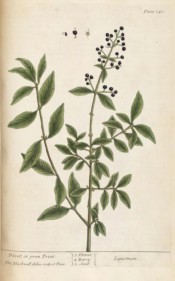Ligustrum vulgare L.
Fully-hardy, bushy, deciduous or semi-evergreen shrub with lance-shaped leaves, to 6cm long, and panicles, to 5cm long, of white flowers in summer, followed by black fruit. To 3m. [RHSE, Hortus, Hilliers’].
Horticultural & Botanical History
Commonly used for ornamental hedging in England and probably an ancient garden plant. ‘Privet or prim Print. Ligustrum. This is a low shrub; the leaves are a grass green, the flowers white & the berries black. It grows in hedges and flowers in May and June, ye berries being ripe in September. The leaves and flowers are accounted cooling drying and astringent; good for ulcers & inflammation of ye throat, bleeding of the gums and relaxation of the uvula. Dioscorides commends the flowers steeped in vinegar as good for the head-ach.’ [Blackwell pl.140/1737].
History at Camden Park
Listed in all published catalogues [T.636/1843]. A significant weed in the gardens and surrounding countryside.
Notes
Ligustrum vulgare Thunb. (1784) = Ligustrum ovalifolium Hassk.
Published Jan 20, 2010 - 12:10 PM | Last updated Jul 28, 2010 - 02:47 PM
| Family | Oleaceae |
|---|---|
| Category | |
| Region of origin | Europe to Asia |
| Synonyms | |
| Common Name | Common privet |
| Name in the Camden Park Record |
Ligustrum vulgare – Privet |
| Confidence level | high |
